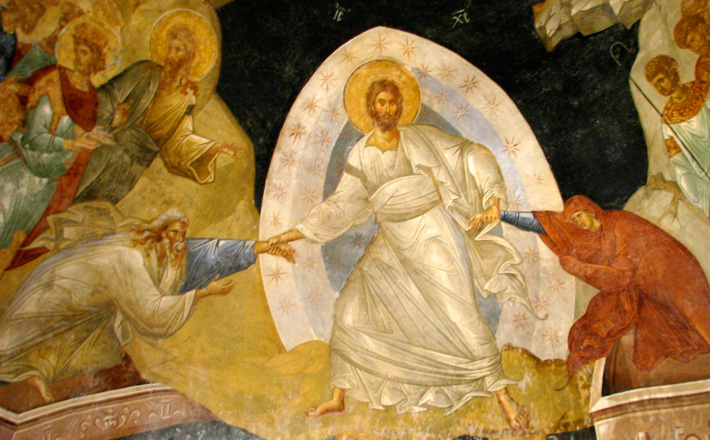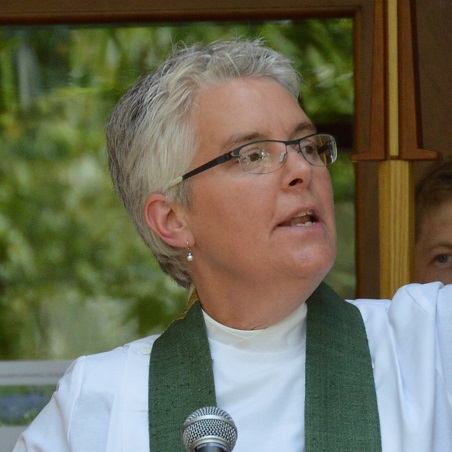Commentary on Matthew 28:1-10
Each Gospel account of Jesus’ resurrection presents the event differently, as though each of the evangelists is struggling to capture an event that they cannot put their arms around, so each of them breaks off some part of it to describe. One of the striking features of Matthew’s account is the contrast between the cosmic and the intimate. Matthew suggests that both are aspects of the life-changing truth of the resurrection, the foundation of the Christian faith.
The women’s visit to the tomb is presented more dramatically in Matthew’s Gospel than in the other accounts. Whereas in Mark’s rendition, the women wonder who will roll away the stone for them, in Matthew’s version that question is answered emphatically: there is an earthquake, and an angel descends from heaven, rolls back the stone, and sits on it. The earthquake parallels the one that occurred as Jesus died on the cross. Both cataclysms are apocalyptic signs of the end times, reinforcing the theological claim that Jesus’ death and resurrection are eschatological events that herald the inbreaking of God’s reign, cosmic disruptions that signal the transformation of the world.
The intervention of the angel makes abundantly clear that the resurrection of Jesus is God’s action. Just as an angel was sent from God to tell Joseph that Mary would bear Emmanuel, God with us, thus setting the story of Jesus in motion (Matthew 1:20), so too at the end of the story an angel again appears to accomplish God’s purposes. As God’s action, the resurrection cannot be thwarted: Pilate and the chief priests make every effort to ensure that Jesus will stay dead, going so far as to seal the stone at the tomb entrance, and placing a guard there (27:62-66). But the angel not only rolls back the stone but sits on it, as if to mock these efforts. Moreover, the sight of the angel makes the guards shake and become as though dead—so much for the efforts of imperial power to thwart God’s purposes. These dramatic elements that Matthew emphasizes in his telling of the story make it clear that God is acting in this event, and that nothing can hinder God’s uncontainable life.
Alongside this cosmic drama, however, Matthew tells another side of this story. Unlike Mark and Luke’s accounts, Matthew recounts a meeting between the women and Jesus after they leave the tomb. This meeting, which parallels in some ways the meeting between Jesus and Mary Magdalene in John’s Gospel (John 20:11-18), starts with Jesus’ salutation: “Greetings!” The Greek word used is a familiar, everyday greeting, and there is something almost humorous about the understatement of this “Hello,” coming from one who was just dead and is now alive. In contrast to John’s account, the women recognize him right away, and are allowed to touch him, reinforcing the familiarity of this meeting. These details suggest that, even though the women fall down and worship Jesus, there are elements of this encounter that have continuity with their former life with Jesus.
This familiarity is significant: as Eugene Boring notes, the Greek word “met” in the phrase, “Suddenly Jesus met them,” (Matthew 28:9) has the connotation of meeting to accompany someone, and suggests the ongoing presence of the risen Jesus in the ministry of the church. Jesus is “Emmanuel,” God with us, and has promised that “when two or three are gathered, I am in the midst of them.” His meeting these women as they are en route to fulfill the mission given them suggests the way that he will continue to be with his disciples as they undertake his mission. He instructs the women to tell his disciples that he will meet them in Galilee, back where he first called them, and when he sees them there, he will again remind him of his ongoing presence with them: “Lo, I am with you always, even to the end of the age” (Matthew 28:20).
The resurrection of Jesus is a total reordering of our world but is also an intimate promise of presence with us. The risen Christ comes alongside us and walks with us, as the road to Emmaus story dramatizes (Luke 24:13-35), and as this encounter with Matthew also conveys. The resurrection of Jesus not only signals the radical transformation of the world that the inbreaking reign of God brings, but also promises that the risen Christ can be with us in the everydayness of our ordinary lives.
Although Matthew portrays both the cosmic drama and the familiar presence the resurrection of Jesus brings about, at the heart of this event there is a gap, an emptiness, a silence. By describing the earthquake, the angel’s descent, and the rolling away of the stone, Matthew comes closer than the other evangelists to describing the resurrection, but neither he nor the other Gospel writers portray the actual event of Jesus’ rising. Whereas the apocryphal Gospel of Peter recounts the moment itself, with two angels assisting the still weak Jesus out of the tomb and walking him toward heaven, the canonical Gospels do not venture to describe this moment. This transition from death to eternal life is a mystery that cannot be described. It is an event that takes place in time and yet is outside of time. It takes place on earth and yet partakes of heaven. It is God’s future breaking into the present. For all these reasons, the resurrection itself cannot be depicted, and any attempts to do so fall so far short of the reality as to be almost blasphemous.
For the same reasons, the resurrection of Jesus cannot be proven. It can only be received in faith, as the women at the tomb received it, in fear and great joy. To receive it is to participate in it—to be invited to proclaim this divine triumph over death, empowered by the lasting and trustworthy presence of the Risen One.
PRAYER OF THE DAY
Alleluia! Christ is risen! He is risen indeed! Receive our unending love and devotion as we celebrate today the undeserved gift of your love. We pray these things in the name of Jesus Christ, our Savior and Lord. Amen.
HYMNS
Jesus Christ is risen today ELW 365, H82 207, NCH 240
Now the green blade rises ELW 379
O sons and daughters, let us sing ELW 387
CHORAL
This joyful Eastertide, arr. Charles Wood
A Repeating Alleluia, Calvin Hampton


April 9, 2023